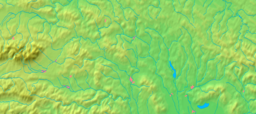Poprad
| Poprad | ||
| City | ||
|
Central Poprad during winter
|
||
|
|
||
| Country | ||
|---|---|---|
| Region | Prešov | |
| District | Poprad | |
| Tourism region | Tatry | |
| River | Poprad | |
| Elevation | 672 m (2,205 ft) | |
| Coordinates | 49°03′34″N 20°17′51″E / 49.05944°N 20.29750°ECoordinates: 49°03′34″N 20°17′51″E / 49.05944°N 20.29750°E | |
| Area | 62.997 km2 (24 sq mi) | |
| Population | 55,042 (2006-12-31) | |
| - metro | 100,000 | |
| Density | 874/km2 (2,264/sq mi) | |
| First mentioned | 1250 | |
| Mayor | Jozef Švagerko | |
| Timezone | CET (UTC+1) | |
| - summer (DST) | CEST (UTC+2) | |
| Postal code | 058 01 | |
| Phone prefix | 421-52 | |
| Car plate | PP | |
| Statistics: MOŠ/MIS | ||
| Website: http://www.poprad.sk | ||
Poprad (Slovak pronunciation: [ˈpoprat]; Hungarian: Poprád, German: Deutschendorf) is a city in northern Slovakia at the foot of the High Tatra Mountains famous for its picturesque historic centre and as a holiday resort. It is the biggest town of the Spiš region and the tenth largest city in Slovakia, with a population of approximately 55,000.
The Poprad-Tatry Airport is an international airport located just outside the city. Poprad is also the starting point of the Tatra Electric Railway (known in Slovak as Tatranská elektrická železnica), a set of special narrow-gauge trains (trams) connecting the resorts in the High Tatras with each other and with Poprad. Main line trains link Poprad to other destinations in Slovakia and beyond; in particular, there are through trains running from Poprad to Prague in the Czech Republic.
The territory was since the Migration Period inhabited by Slavic settlers. The first written record dates from 16 March 1256 in the deed of donation of the Hungarian King Bela IV. It was colonized in the 13th century by German settlers and became the largely German town Deutschendorf meaning 'Germans' village'. From 1412 to 1770, as one of the Szepes towns, Poprad was pawned by the Kingdom of Hungary to the Kingdom of Poland, resulting in a strong Polish influence on the city's further development. In the 17th century, the number of Germans began to decline. In January 1919 was this territory taken under the Czechoslovak control.
...
Wikipedia






